Watching a talent show, be it on TV or at a school event, is entertaining. However, having your child participate provides an even more enriching experience. Yet, navigating through a myriad of talent show ideas for kids can seem daunting given the vast array of choices.

Talent showcases present a special opportunity for your child to display their abilities and voice their creativity. These events not only amplify their self-confidence but also help them tackle stage anxiety. Therefore, it’s pivotal to select an activity or creative art form that best accentuates your child’s unique talent in a fresh and engaging manner.
At school talent shows, the array of talents children choose to showcase is a vivid testament to their diverse interests and passions. While some may opt for traditional performances like singing or dancing, others venture into more unconventional territories, be it a mesmerizing magic trick, a captivating storytelling session, or even a display of technological prowess.
Speaking of unique talents, some students also decide to show off their sports skills:
6-year-old shows off her deadlift strength for her school talent show!💪🏼
65 lbs (10 lbs over her body weight)🤯 pic.twitter.com/D1xVQR7v4W
— Squat University (@SquatUniversity) May 25, 2023
Regardless of the act, these shows provide a valuable platform for students to express themselves, emphasizing that every talent, whether mainstream or unconventional, deserves celebration and applause. Dive into this article to glean insights from top talent show suggestions for kids and to understand the factors pivotal in making the best choice for your young performer.
1. Mimic with Lip-Sync
Difficulty Level: Low
Participants: Solo or Group
Needed: Recorded song, microphone for effect
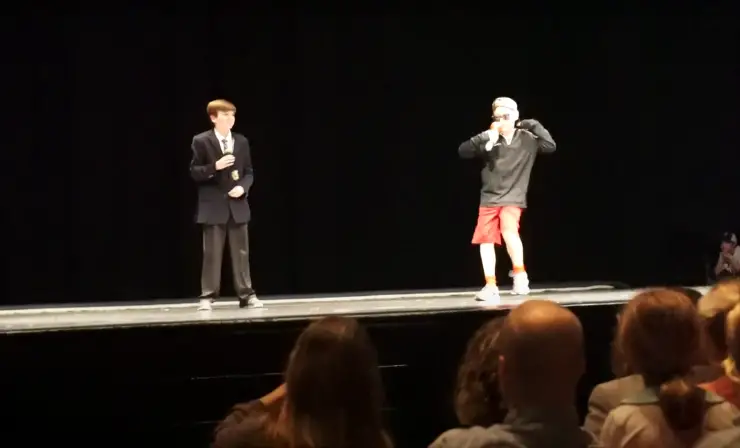
Lip-syncing is an excellent talent show concept, especially suited for elementary school students. It acknowledges that not every child possesses a naturally gifted singing voice, offering them an opportunity to express themselves through music without the challenges of vocal delivery.
This entertaining activity simply requires a love of music and a commitment to learning song lyrics. It empowers children to showcase their passion for music and performance, allowing them to step into the shoes of their favorite artists and bring songs to life through expressive gestures and movements. Lip-syncing is an inclusive and enjoyable way for young talents to shine on stage, celebrating their creativity and enthusiasm.
Tips for a Successful Lip-Sync Performance
- Incorporate Dance: Merging a few dance moves can elevate the performance, making it lively and inviting. It allows students to delve deeper into the song and express it with their bodies.
- Choose Fun Props: Using props can add a layer of creativity and excitement. Whether it’s a faux microphone or a costume that complements the song, props can make a difference.
- Group Performances: Allow students to team up. Group lip-syncs can be particularly entertaining, fostering collaboration and shared enthusiasm.
In summary, lip-syncing is an inclusive talent show avenue, ensuring every student has the chance to shine, express their artistic side, and most importantly, enjoy the moment. Check out our article about musical activities to help your kid develop musicality.
Watch as these talented students light up the stage in an epic lip-sync battle at their school talent show:
2. Sync with Hand Claps
Difficulty Level: Low
Participants: Solo or Group
Needed: Music (optional)
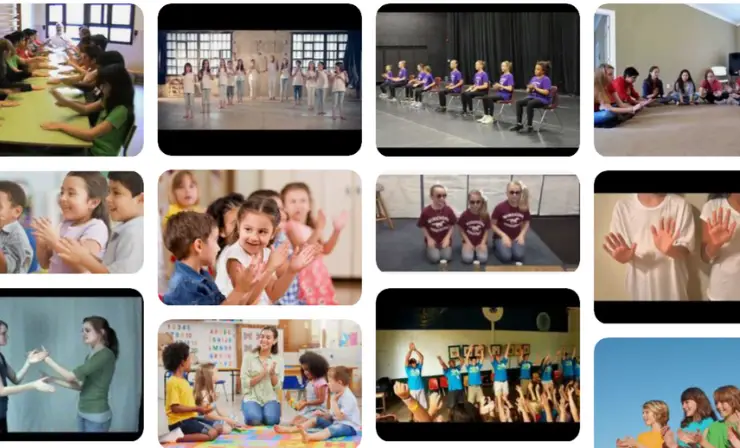
Hand clapping, commonly seen as a basic gesture, can morph into a captivating talent show performance with the right mix of innovation and finesse. For young students, it presents an opportunity to exhibit rhythm, coordination, and camaraderie.
While hand clapping might appear simple, crafting it into a memorable act demands precision and dedication. Synchronizing with popular tunes or crafting unique beats, especially when merged with synchronized motions, can leave audiences enthralled.
Tips for a Memorable Hand Clapping Performance
- Introduce Accessories: Incorporating gloves can be a game-changer. Besides offering visual allure, they can produce varied sounds, enriching the audience’s auditory experience.
- Collaborate: While a solo performance highlights individual prowess, joining forces with peers can magnify the act’s appeal. Together, participants can concoct intricate rhythms and even weave stories using only their hands.
- Experiment and Evolve: As proficiency grows, students can explore different variations and incorporate fresh elements, ensuring the act remains dynamic.
- Practice Makes Perfect: Given its reliance on timing, regular practice is essential to ensure the act is seamless and impactful.
In essence, hand clapping, when approached as a talent show idea, showcases a fusion of creativity and rhythm. It underlines the fact that with imagination and dedication, even fundamental gestures can make a profound impact.
Take a look at this video to see a hand clapping performance showcased:
3. Create Floating Bubbles
Difficulty Level: Low
Participants: Solo
Needed: Bubble solution, bubble wands
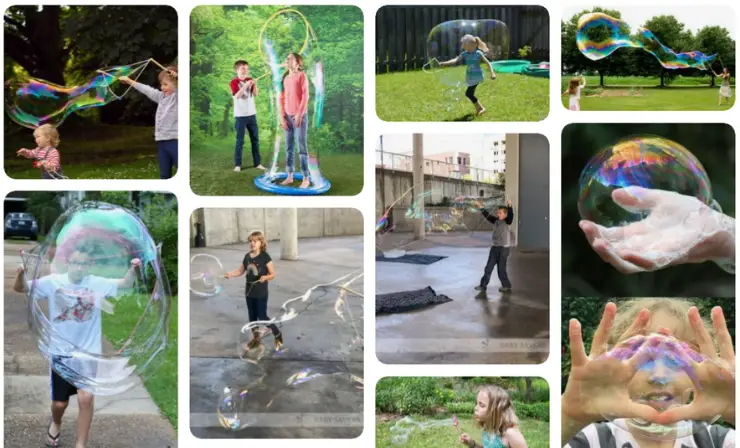
In an elementary school talent show, a bubble-blowing act can captivate viewers with its blend of magic and nostalgia. The success of this performance hinges on the experimentation with solutions, potentially enhanced with glycerin or corn syrup, which allows for the creation of more resilient bubbles.
Utilizing various rings and tools, performers can craft a diverse array of bubbles, from the tiniest delicate spheres to large radiant orbs, and even adopt unique shapes like stars or hearts. When synchronized with music, the display becomes even more enchanting, as the bubbles dance in harmony with the rhythm. This act serves as a beautiful reminder of the fleeting, simple joys life offers.
Tips for a Successful Bubble-Blowing Performance
- Environment Matters: Ensure the performance area is free from drafts or strong air currents that can interfere with the bubbles. A slightly humid environment can make bubbles last longer.
- Practice Different Techniques: Before the actual performance, children should practice different bubble-blowing techniques, such as producing multiple bubbles at once or creating bubbles inside bubbles, to add depth to their show.
- Safety First: While most bubble solutions are non-toxic, make sure kids avoid ingesting any and always have a cleanup station nearby as spilled solutions can make the floor slippery.
- Interactive Element: Consider allowing some audience members, especially younger children, to chase or pop a few bubbles towards the end of the performance. This can make the act more engaging and memorable for everyone involved.
Check out this video to see a bubble blowing performance in action:
4. Grace the Stage with Knee Dance
Difficulty Level: Low
Participants: Group
Needed: Music, dark blanket
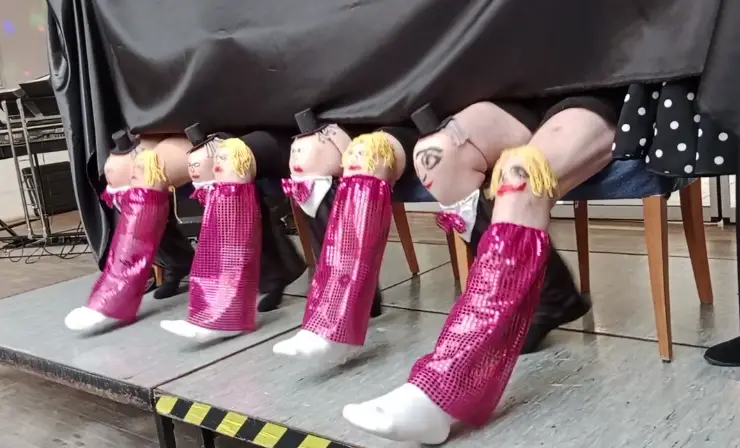
The knee dance is a whimsical performance idea that turns traditional dance on its head, making it an engaging fit for elementary school talent shows. Ideal for those hesitant about their dance skills, this act shines the light on an unexpected star: the knees. Preparation is about dressing the lower legs in comical costumes like mini tutus, with the knees painted as expressive faces.
As children perform hidden behind dark blankets, their animated “knee” characters dance, twirl, and converse, eliciting laughter and applause. When performed collectively, the charm intensifies, creating an uproarious ensemble. All in all, the knee dance emphasizes that a dash of innovation can turn anyone into a talent show sensation.
Tips for a Knee Dance Performance
- Character Creation: Spend time brainstorming and designing the knee characters. Whether it’s a famous personality, an animal, or a unique fictional character, the more distinct and humorous the knee personality, the better.
- Music Selection: Choose a lively and catchy tune that aligns with the theme or story of the knee characters. The right music can enhance the overall performance, making the dance sequences more engaging and synchronized.
- Practice Transitions: Smooth transitions between different dance moves will ensure the performance flows seamlessly. Additionally, if performing in a group, rehearse coordinated moves to maintain synchronization.
- Incorporate Props: Introduce miniature props that the knee characters can interact with, such as tiny hats, wands, or umbrellas. These props can aid in storytelling, add depth to the performance, and induce more laughs from the audience.
Check out this video for a demonstration of the knee dance:
5. Dance with Pillow People
Difficulty Level: Low to Middle
Participants: Solo or Group
Needed: Pillows, drawing materials for emojis, music for dance

The “pillow people dance” breathes new life into traditional performances, showcasing a unique blend of humor and creativity tailored for elementary talent shows. Children dance with emoji-decorated pillows strapped to their faces, turning a simple prop into a canvas of comedic expressions.
As the music starts, their lively movements paired with static emoji faces become a spectacle, eliciting laughter from the audience. Beyond just dance, this act opens avenues for storytelling, with each emoji hinting at a character’s narrative. In its essence, the pillow people dance highlights the boundless imagination of young performers, transforming the ordinary into an unforgettable act.
Tips for the “Pillow People Dance”
- Selection of Emojis: Choose a range of relatable emojis – from laughing to surprised – to ensure a dynamic and varied performance.
- Storytelling Element: Beyond just dancing, use the emoji pillows to represent characters and enact humorous, short skits or everyday scenes.
- Music Sync: Pick a lively track that complements the theme. Music with changing tempos can be perfect to reflect the different moods of the emojis.
- Costume Coordination: While the pillows are the main attraction, coordinating outfits or using thematic costumes can enhance the overall visual impact.
In conclusion, the “pillow people dance” underscores the endless creativity of children. Using a simple prop like a pillow, young performers can transform an ordinary item into the star of a remarkable and memorable act.
Take a look at this video to see the pillow people dance in action:
6. Skip with a Rope
Difficulty Level: Low to Medium
Participants: Solo or Group
Needed: Jump rope
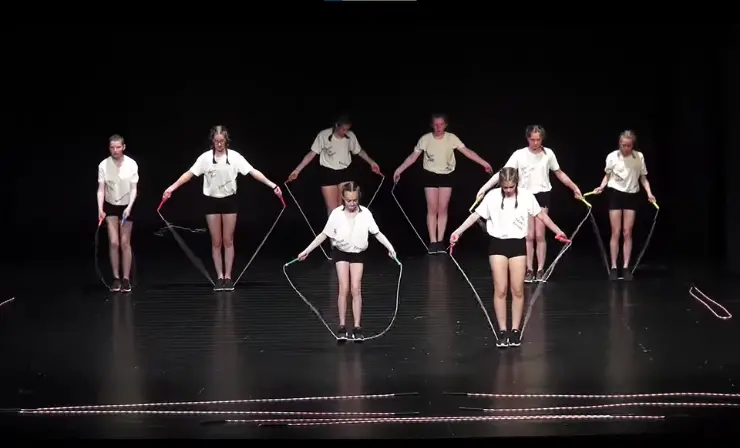
Jumping rope, more than just a childhood game, can transform into a captivating highlight for an elementary school talent show. With the right blend of creativity, this nostalgic activity becomes a rhythmic spectacle, merging agility with synchronized dance.
Pairing the jumps with upbeat music adds dynamism, while introducing lights amplifies the visual appeal. Whether solo or with friends, the performance possibilities, from tandem jumps to synchronized routines, are vast. Yet, practicing on the actual stage beforehand is vital, ensuring performers are familiar with the space, leading to a seamless and memorable show.
Tips for a Standout Jump Rope Performance
- Musical Sync: Choose an upbeat song and synchronize the jumps with its rhythm, ensuring the act remains dynamic and engaging throughout.
- Team Dynamics: While solo performances can shine a spotlight on individual prowess, involving friends can add layers of synchronized jumps and collaborative patterns, enhancing the overall visual appeal.
- Lighting Effects: Introducing vibrant lighting can add drama, casting intriguing shadows as the performers jump and the rope twirls.
- Rehearse in the Actual Space: To prevent any unforeseen issues, practicing on the actual stage is crucial. It helps in understanding the space dynamics, ensuring seamless transitions and avoiding mishaps during the live performance.
With these elements in place, the jump rope performance is bound to evoke both nostalgia and admiration, making it a memorable act of the night.
Watch this video for an example of a rope jumping performance:
7. Showcase Simple Magic
Difficulty Level: Low to Medium
Participants: Solo
Needed: Magic props
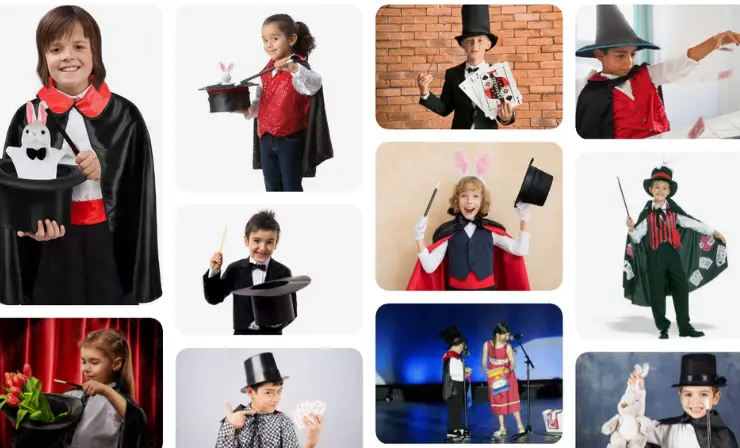
Magic acts have a timeless appeal, enchanting talent show audiences with wonder and amazement. For young students, performing magic can be their moment to captivate peers and adults using beginner-friendly tricks from accessible magic kits. These kits often contain safe yet astonishing tricks tailored for novice magicians, from mind-bending card tricks to vanishing scarf acts.
Practice is the cornerstone of an impressive magic act. Through regular rehearsals, young performers can refine their tricks to perfection. Support from guardians in the form of feedback and encouragement can further enhance their act. With dedication and confidence, these young magicians can turn a talent show into a mesmerizing spectacle.
Tips for a Successful Elementary School Magic Act
- Start with a Magic Kit: Beginner magicians can benefit from purchasing a magic kit. Available both online and at local stores, these kits are equipped with a range of easy-to-learn tricks and safe props, perfect for a first-time performance.
- Practice, Practice, Practice: The key to magic lies in seamless execution. Encourage regular rehearsals to master each trick, ensuring that every move feels natural and confident by the time of the performance.
- Seek Feedback: Having an initial audience, such as guardians or friends, can be invaluable. They can provide constructive feedback, helping the young magician refine their act and build confidence.
- Engage the Audience: Beyond the trick itself, the way it’s presented matters. Teach young performers the art of storytelling and presentation, ensuring that they connect with the audience, adding depth to the magic act.
Check out this video to see a sample magic performance:
8. Spin the Hula Hoop
Difficulty Level: Low to Medium
Participants: Solo
Needed: Hula hoop
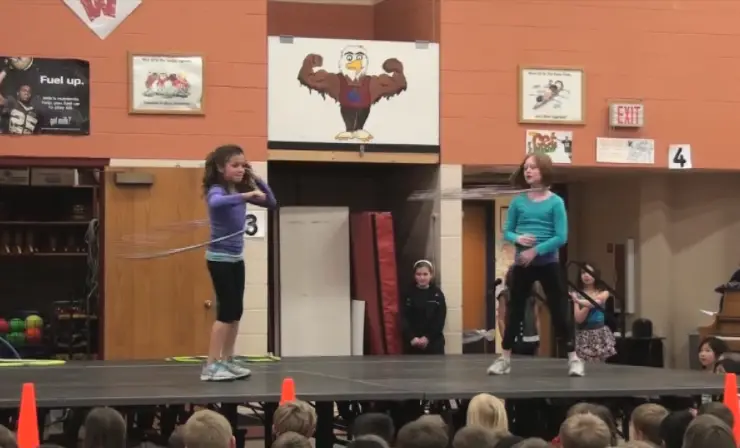
Hula hooping, more than a childhood pastime, can be elevated into a captivating talent show act for elementary students. This playful activity, when presented on stage, unfolds as a dynamic and colorful spectacle. Beyond basic waist rotations, incorporating a variety of tricks—like spinning the hoop around the neck or transitioning between body parts—can leave the audience astounded.
For advanced performers, handling multiple hoops simultaneously adds another dimension of intrigue. However, extensive rehearsal is paramount. It refines the act and boosts the performer’s confidence. Ultimately, a hula hoop performance combines artistry with athleticism, promising a memorable and enchanting showcase.
Tips for a Hula Hoop Talent Show Act
- Diverse Movements: Encourage performers to go beyond the basic waist rotation. Incorporate a range of moves such as spinning the hoop around the neck, ankles, or transitioning smoothly between different body parts. This diversity keeps the act fresh and captivating.
- Multi-Hoop Mastery: For added spectacle, consider introducing multi-hoop performances. This adds a layer of complexity, showcasing advanced skills. However, ensure the performer is comfortable and has practiced extensively with multiple hoops before including them in the act.
- Consistent Rehearsals: Dedicate ample time for rehearsals. Practicing regularly will not only improve the execution of the tricks but also boost the performer’s confidence, ensuring a smoother final performance.
- Engage with the Audience: The vibrant and dynamic nature of hula hooping is perfect for engaging the audience. Encourage the performer to maintain eye contact, smile, and possibly move closer to the audience or across the stage, making the act more interactive and memorable.
Check out this video to see a hula hoop performance in action:
9. Parade in a Fashion Show
Difficulty Level: Low to Medium
Participants: Group
Needed: Costumes, runway, music
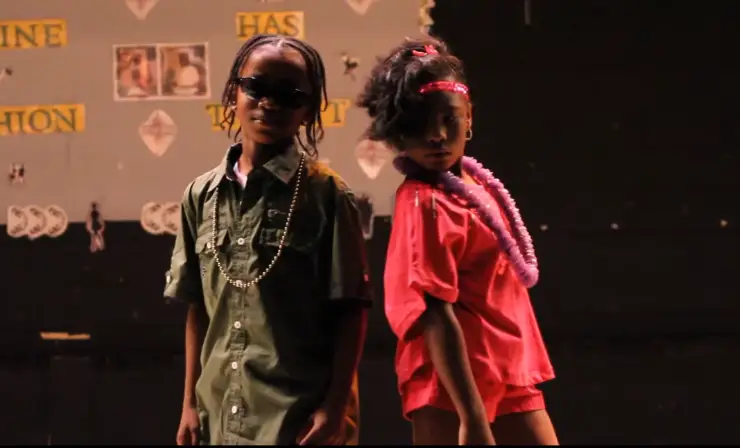
A fashion show segment can be a dynamic highlight in an elementary school talent show. It offers young fashion enthusiasts a platform to express themselves and share their unique style. Children choosing their outfits adds authenticity, whether inspired by current trends or their imaginative designs, allowing personal stories to grace the runway.
Including both the spotlight-loving kids and those who prefer working behind the scenes ensures inclusivity. The addition of mood-enhancing music and dramatic lighting further transforms the stage into a vibrant runway. Overall, this segment celebrates young creativity, blending fashion with the spirited energy of youth.
Tips for a Standout Runway Performance
- Encourage Personal Expression: Allow children to select or design their outfits, ensuring each piece resonates with their personal style. This will reflect their individuality and make the show more authentic.
- Collaboration is Key: Promote teamwork by involving kids in various roles. While some can be the models, others can assist with styling, make-up, or even set design, making the event more inclusive.
- Set the Mood with Audio-Visuals: Choose a thematic soundtrack that complements the mood of the fashion show. Pair it with dynamic lighting to create an atmosphere that transforms the regular stage into a glamorous runway.
- Rehearse the Runway: Before the main event, conduct a few practice runs. This helps the young models build confidence and ensures smooth transitions between presentations, leading to a seamless show.
Take a look at this video to see a sample fashion show performance:
10. Strum an Instrument
Difficulty Level: Low to High
Participants: Solo or Group
Needed: Instrument(s)

Musical performances have always held a special place in talent shows, especially for budding elementary school musicians. The journey of mastering an instrument is both challenging and rewarding, and showcasing this skill can be a proud moment for any young artist. Letting your child pick their favorite instrument and tune ensures they perform with passion and confidence.
Regular practice at home is essential for fine-tuning their performance. Instruments like recorders, keyboards, and ukuleles are perfect for younger students due to their simplicity and delightful sound. Witnessing a child’s dedication through each note not only demonstrates their talent but also provides a memorable experience for all attendees.
Tips for Young Instrumentalists
- Personalized Selection: Encourage your child to select an instrument and song that they truly resonate with. This personal connection can elevate their performance and boost their confidence on stage.
- Consistent Practice: Dedicate specific times for regular practice at home. This helps in mastering the chosen song, adjusting the pace, and ensuring a flawless performance during the talent show.
- Opt for Beginner-Friendly Instruments: Instruments like recorders, keyboards, and ukuleles are excellent choices for young performers. They are easy to handle, learn, and produce captivating tunes.
- Performance Feedback: Arrange mini-performances at home, allowing family or friends to watch. Their feedback can provide valuable insights and give the child a sense of an actual audience, preparing them for the main event.
Watch this video to see a sample of an elementary school drum performance:
11. Dance to the Beat
Difficulty Level: Low to High
Participants: Solo or Group
Needed: Music, possibly costumes
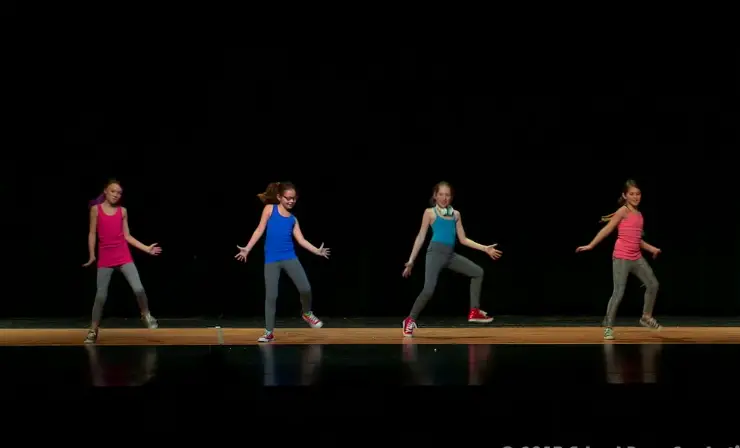
Dance performances are a highlight in elementary school talent shows, captivating audiences with a fusion of rhythm and expression. Tailoring the act to your child’s interest, from the elegance of ballet to the lively beats of freestyle, enhances their comfort and engagement. Pairing the chosen dance form with complementary music and attire can elevate the entire spectacle.
Dance is versatile, allowing solo spotlights or collaborative group performances. Choreography set to popular children’s tunes resonates with the young audience, forging a delightful musical bond. At its core, these dance segments celebrate youthful energy and the joy of movement, ensuring a memorable show for all.
Tips for a Dance Segment in a Talent Show
- Personalize the Performance: Begin by understanding your child’s dancing preferences and comfort level. Whether it’s ballet, tap, or freestyle, selecting a genre they’re passionate about will reflect in their performance.
- Synchronize Music and Costume: A captivating dance act goes beyond just the steps. Ensure that the chosen music and costume align with the dance style, creating a cohesive and mesmerizing presentation.
- Solo or Group: Evaluate whether your child shines brightest in a solo spotlight or if they thrive in group dynamics. Each has its charm, so choose based on their confidence and preference.
- Familiar Tunes for Connection: Choreograph the dance to popular children’s songs. This not only adds a touch of familiarity but also ensures an instant connection between the performers and the young audience.
Take a look at this video to see a dance performance sample:
12. Sing Your Heart Out
Difficulty Level: Low to High
Participants: Solo or Group
Needed: Microphone, background music
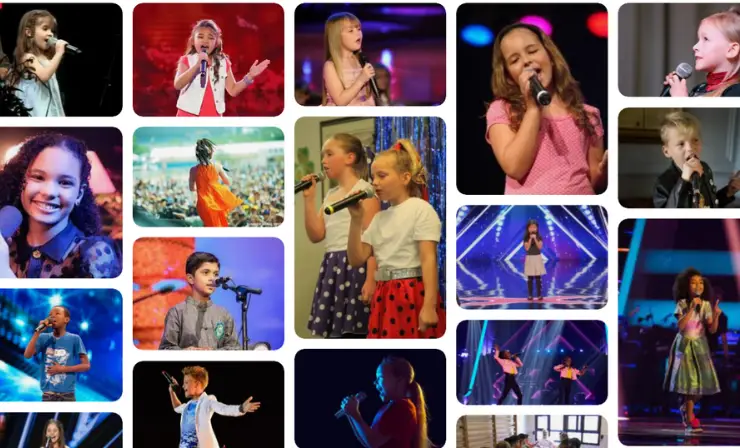
Singing is a cherished talent show option for elementary students, allowing their youthful voices to charm audiences. Choosing a song that aligns with your child’s comfort is vital, paired with dedicated practice sessions. As caregivers, guiding their rehearsals and providing feedback can enhance their confidence.
The versatility of singing means kids can opt for a solo spotlight or harmonize in a group. Familiar children’s tunes can be the perfect choice, ensuring both performers and audience members connect. Ultimately, singing offers a blend of vocal talent and emotional expression, making it a heartwarming addition to any elementary talent show.
Don’t know which song to choose? Check out our list of school appropriate songs.
Tips for a Singing Act
- Song Selection is Key: Opt for a song that your child relates to and feels confident performing. Familiar kid-friendly tunes or classic nursery rhymes are usually a hit, as they resonate with both performers and the audience.
- Regular Rehearsals: Practice makes perfect. Encourage regular rehearsals to familiarize the child with the song’s tempo and lyrics. As a caregiver, your active involvement in these sessions—offering feedback and encouragement—can bolster their confidence.
- Choose the Performance Type: Whether it’s a solo or a group act, decide based on the child’s comfort level. Group performances can offer a sense of camaraderie, while solo acts allow individual talents to shine. Ensure the chosen format aligns with the child’s preference and confidence level.
Take a look at this video to see a singing performance example:
13. Demonstrate Karate Moves
Difficulty Level: Medium
Participants: Solo or Group
Needed: Karate uniform, belts
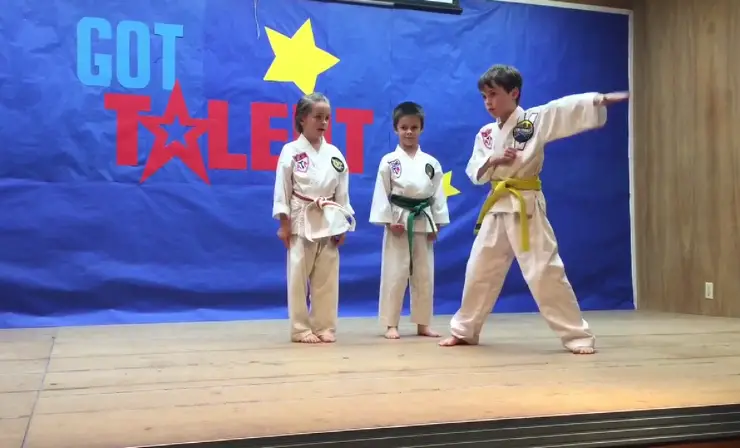
Karate, with its blend of discipline and strength, offers a captivating act for elementary school talent shows. If your child practices karate, their stage demonstration can be a blend of empowerment and entertainment. A proper “gi” (karate uniform) is vital for authenticity, while thorough practice ensures precision in every move, from stances to kicks.
Enhancing the performance with props, like foam targets, can visually display techniques to the audience. A highlight, such as breaking a board, showcases sheer power, leaving viewers astounded. Overall, a karate act underscores the dedication and resilience inherent in this martial art, inspiring others through the power of practice and determination.
Tips for a Karate-Based Talent Show Act
- Authenticity and Comfort in Attire: Ensure the child wears a proper “gi” or traditional karate uniform. This not only adds an authentic touch to the performance but also ensures comfort and unrestricted movement, vital for demonstrating various techniques.
- Routine Mastery Through Practice: Dedicate ample time to rehearse the chosen routine, focusing on every detail, from basic stances to intricate kicks. Consistent practice guarantees that each move exudes confidence and is flawlessly executed during the performance.
- Engage with Props for Visual Impact: Integrate props such as foam targets to accentuate punches or kicks, providing a clearer understanding for the audience. Consider concluding with a board-breaking act, demonstrating both power and precision, leaving a lasting impression on spectators.
Take a look at this video to see an example of a karate demonstration:
14. Illuminate with the Glowing Stick Dance
Difficulty Level: Medium
Participants: Solo or Group
Needed: Glow sticks, black clothing, music
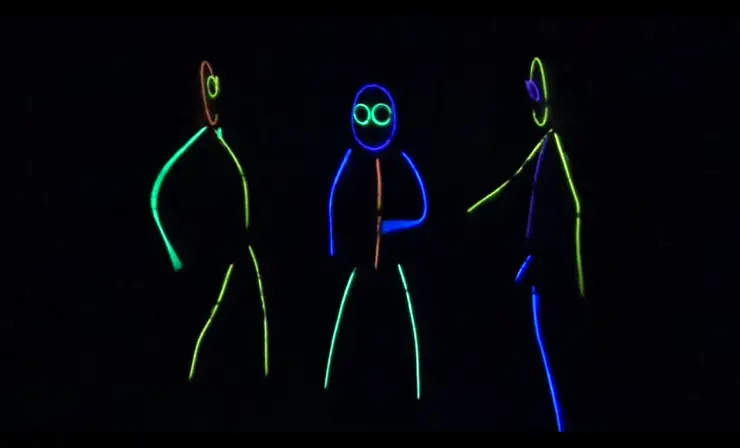
The glowing stick dance, with its radiant allure, is gaining traction, especially on social media platforms, making it an exciting choice for elementary school talent shows. Performers wear plain black attire, enhancing the luminance of strategically attached glowsticks. When lights dim, these sticks give the illusion of animated stick figures, creating a captivating visual treat.
Choosing a lively song is vital, bringing the glowing figure to life with every beat. Regular practice ensures seamless synchronization to the music, making each movement of the glowstick-clad figure enchantingly fluid. This innovative dance, intertwining imagination and rhythm, promises a mesmerizing performance that’ll dazzle audiences.
Tips for the Glowing Stick Dance
- Glowstick Variety: Ensure a captivating visual effect by using a variety of bright and colorful glowsticks. Experiment with different shapes and sizes to make the dancing stick figure more dynamic and visually appealing.
- Song Selection: Choose an upbeat and rhythmic song that complements the energetic movements of the glowing stick dance. The music should enhance the performance, syncing well with the dance routine.
- Practice and Coordination: Rehearse the dance steps rigorously to ensure synchronization with the music. Focus on fluidity and grace in movements to create a mesmerizing visual spectacle. Practice with the glowsticks in dim lighting to perfect the illusion.
Have a look at this video for a demonstration of a glow stick dance performance:
15. Jump using a Pogo Stick
Difficulty Level: Medium
Participants: Solo or Group
Needed: Pogo sticks, safety gear (like helmets and knee pads)
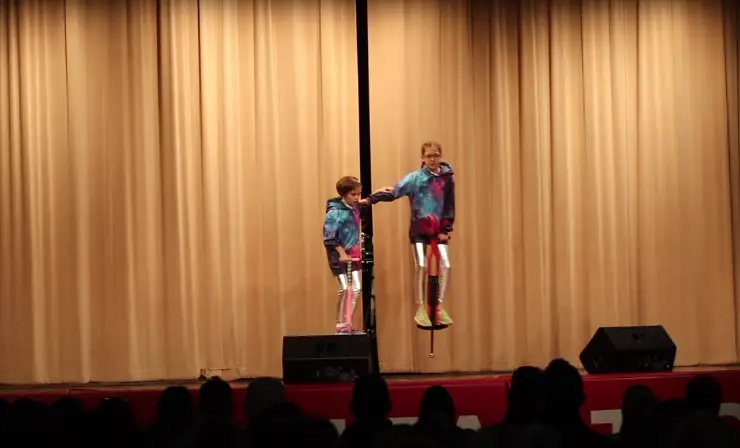
Performing on pogo sticks has always fascinated children, combining the joy of bouncing with the challenge of balance. Introducing a pogo stick act in an elementary school talent show offers a refreshing departure from traditional acts, promising an engaging display of agility and coordination.
The key to an impressive pogo stick routine lies in choreography. Incorporating tricks like leaping over chairs or gracefully navigating figure-eight patterns not only showcases the performer’s skills but also adds complexity to the routine. Synchronizing these moves to an upbeat song creates a harmonious fusion of motion and melody, making the performance dynamic and captivating. Thorough practice is crucial to ensure a flawless and safe performance, making this act a memorable highlight of the talent show.
Tips for a Pogo Stick Performance
- Choreograph with Tricks: While bouncing on a pogo stick is entertaining, incorporating tricks adds depth to the routine. Include moves like jumping over objects or navigating figure-eight patterns. These tricks not only showcase skills but also make the performance captivating and memorable.
- Sync with Energetic Music: Choose an upbeat song and synchronize jumps and tricks with its tempo. This creates a dynamic fusion of motion and melody, enhancing the overall appeal of the act. The rhythmic coordination adds an extra layer of excitement for the audience.
- Prioritize Practice and Safety: Extensive practice is vital for a flawless and safe performance. Ensure the young performer masters each jump and trick to perfection. Safety should be paramount, so take precautions and supervise practice sessions to prevent accidents.
View this video to see an example of a pogo stick performance:
16. Whirl in Twirling
Difficulty Level: Medium
Participants: Solo or Group
Needed: Baton or ribbon, music
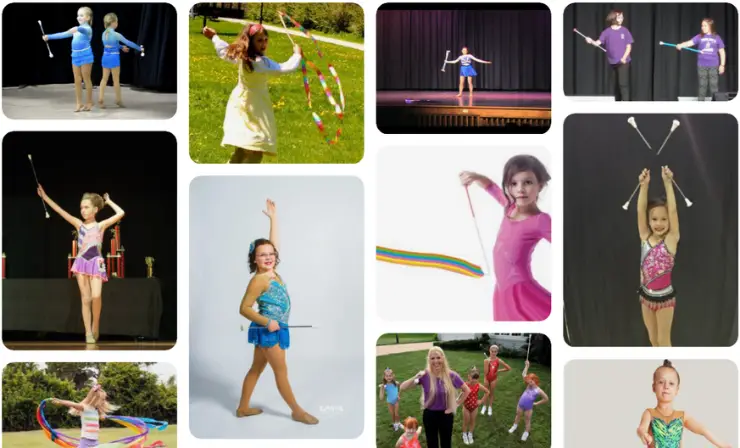
Twirling, an elegant and graceful dance form, can shine in an elementary school talent show, epitomizing dance’s pure essence. Music choice is pivotal; slow, emotive melodies set the stage. As the music flows, watching a child immerse themselves in twirling becomes a heartwarming spectacle. Their gentle arcs and spins, in harmony with the music, create a dreamy ambiance.
A solo twirling act highlights individual grace, but a synchronized group adds complexity and allure. Flawlessly executed group performances can leave an indelible mark, creating moments of shared wonder. In essence, twirling in an elementary talent show celebrates the art of dance in all its splendor.
Tips for a Twirling Talent Show Act
- Song Selection: Choose a slow, romantic song with emotive melodies to provide the perfect backdrop for your twirling performance. The music should complement the graceful arcs and spins, creating a dreamy ambiance that captivates the audience.
- Practice Group Synchronization: If performing as a group, practice synchronized twirling diligently. Ensure each movement is mirrored by all dancers to showcase not only individual talent but also the harmony and coordination of the group. Flawless execution can leave a lasting impression on the audience.
- Embrace Fluid Movements: Emphasize the fluidity and grace of twirling’s movements. Lose yourself in the dance, allowing your passion for the art to shine through. When music, movement, and passion come together harmoniously, it creates a captivating and memorable performance.
Watch this video to experience the beauty of a twirling performance:
17. Glide in a Hoverboard Routine
Difficulty Level: Medium
Participants: Solo or Group
Needed: Hoverboards, suitable area for practice, safety gear (like helmets)
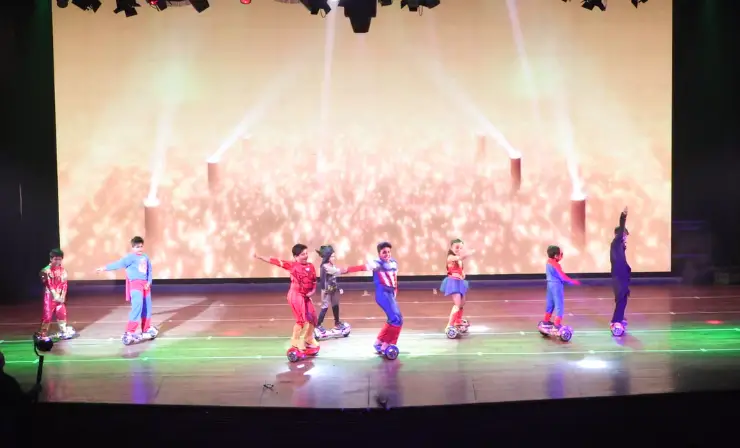
In today’s talent shows, the hoverboard routine is a modern and captivating act for elementary school showcases. It combines technology and tradition to promise visually stunning entertainment. Picture young performers gracefully gliding on hoverboards, moving with the music and executing seamless twists and spins.
Beyond dancing, hoverboards offer creative possibilities, allowing performers to craft narratives, perhaps portraying a futuristic world or reimagining classic tales with a modern twist. Embracing the hoverboard routine celebrates the adaptability and creativity of the young generation, blending tradition and innovation to capture the spirit of modern children and leave audiences in awe.
Tips for a Hoverboard Act
- Master Control: Prioritize learning and mastering control over the hoverboard. It’s essential that performers are comfortable and confident in their movements. Start with basic maneuvers and gradually incorporate more complex tricks as their skills improve.
- Creative Storytelling: Encourage performers to explore creative storytelling through their routine. Whether it’s crafting a futuristic narrative or putting a modern twist on a classic story, the hoverboard routine can be a platform for imaginative storytelling that engages the audience.
- Safety First: Safety is paramount. Ensure that performers wear appropriate safety gear, including helmets, knee pads, and elbow pads. Additionally, practice and rehearse routines in a controlled environment to minimize the risk of accidents during the actual performance.
Watch this video for an exciting hoverboard dancing performance:
18. Dance in Shadows
Difficulty Level: Medium
Participants: Solo or Group
Needed: Translucent screen, focused lighting (often a single spotlight or projector), darkened room or stage setting
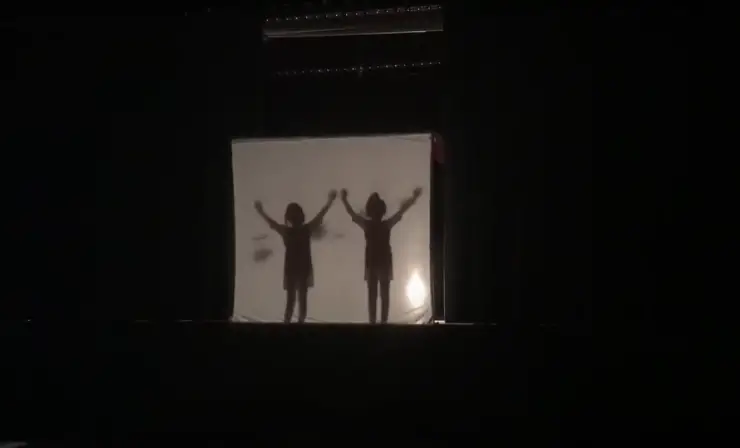
Shadow dance, an enchanting blend of storytelling and movement, offers a captivating avenue for talent expression, ideal for elementary school talent shows. In the dimly lit auditorium, a solitary light illuminates a translucent screen, bringing silhouettes to life. This art form focuses solely on the dancer’s movement, eliminating the need for elaborate costumes or props.
It’s perfect for students who may struggle with stage fright, as it offers anonymity while empowering their creativity. Shadow dance is a testament to the power of raw emotion and storytelling, emphasizing simplicity and authenticity in crafting captivating tales.
Tips for a Shadow Dance Performance
- Careful Choreography: Plan your dance routine meticulously. Since the focus is on movement and storytelling, choreograph every gesture, pose, and transition to convey your narrative effectively. Practice timing and coordination to ensure your performance flows seamlessly.
- Lighting and Screen Setup: Work closely with the technical team to perfect the lighting setup. Ensure that the single light source casting shadows onto the translucent screen is positioned correctly to create the desired silhouettes. Test this setup extensively before the performance to avoid any surprises.
- Embrace Anonymity: If you or your child experience stage fright, remember that shadow dance allows for anonymity. Embrace this aspect and use it to your advantage. Focus on the art and storytelling without worrying about the audience’s direct gaze, letting your creativity shine without inhibition.
Have a look at this video to experience a shadow dance performance:
19. Throw Your Voice as a Ventriloquist
Difficulty Level: Medium
Participants: Solo
Needed: Puppet or dummy, potential script or set of jokes
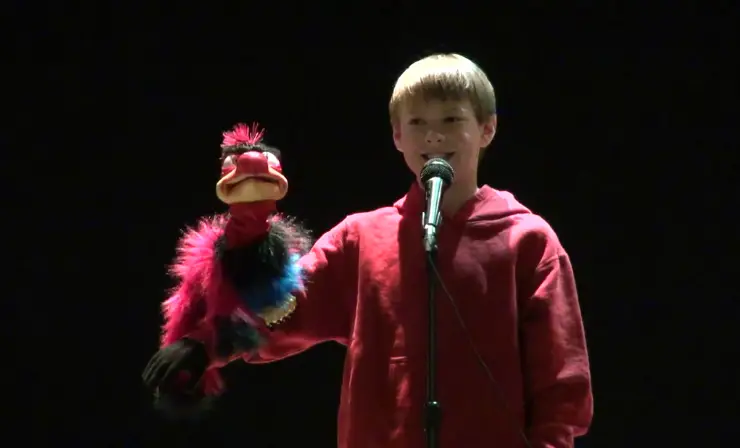
Ventriloquism, the art of making a puppet appear to speak, is a captivating addition to an elementary school talent show. It combines humor and skill, leaving the audience in stitches. The comical effect of a puppet delivering jokes enhances the humor. Even a simple puppet can work, and with practice, your child can master the technique of “throwing their voice.”
Ventriloquism provides kids with the freedom to display a playful persona behind the puppet, delivering witty comments that are both endearing and hilarious. In essence, ventriloquism offers a unique and amusing talent for an elementary school talent show.
Tips for a Ventriloquism Act
- Select the Right Puppet: Start with a simple puppet, such as a hand-controlled one or a creatively designed sock puppet. It’s not about the puppet’s complexity but how well you can bring it to life through your ventriloquism skills. Choose a puppet with exaggerated expressions and distinct character traits to enhance the comedic effect.
- Practice Your Ventriloquism: Mastering the art of “throwing your voice” takes practice. Focus on maintaining a still mouth while speaking through the puppet to create the illusion that it’s talking. Work on the nuances of voice projection and puppet manipulation to make the performance seamless.
- Develop a Playful Persona: Embrace the freedom ventriloquism offers. Behind the puppet, you can adopt a cheeky persona that delivers witty comments and punchlines. Develop a comedic rapport between yourself and the puppet, creating a dynamic that’s both entertaining and endearing.
Watch this video for an entertaining ventriloquist act:
20. Dramatize in a Skit
Difficulty Level: Medium
Participants: Group
Needed: Script, costumes, props
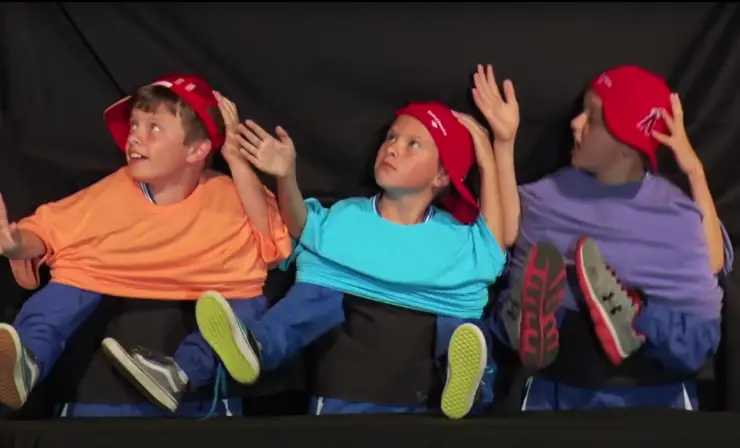
Skit performances are a hit at elementary school talent shows, offering brief yet impactful storytelling moments. Popular tales like “Little Red Riding Hood” or original narratives provide engaging material. You can also pick a story from our list.
Rehearsing skits isn’t just about acting; it fosters teamwork, delegation, and decision-making. Each participant, whether acting or managing props, plays a crucial role, teaching life skills. Through this process, young actors delve into storytelling nuances, understanding pacing, tone, and character development. In essence, skits entertain and mold confident, collaborative, and creative individuals on the elementary school stage.
Tips for Organizing a Skit Performance
- Choose the Right Story: Consider selecting a familiar story like “Little Red Riding Hood” or crafting an original narrative. Familiar tales create an instant connection with the audience, while original stories showcase creativity and imagination.
- Emphasize Teamwork: Skit rehearsals are more than just acting practice; they teach teamwork, delegation, and decision-making. Every participant, whether acting, directing, or managing props, plays a crucial role. Success depends on their collective efforts.
- Explore Storytelling Nuances: Encourage young actors to delve into storytelling nuances such as pacing, tone, and character development. This not only improves the skit’s quality but also enhances their overall understanding of storytelling.
Watch this video to view a skit from a talent show:
21. Perform Gymnastics
Difficulty Level: Medium to High
Participants: Solo or Group
Needed: Safety mats, suitable attire, potentially a coach or instructor for guidance
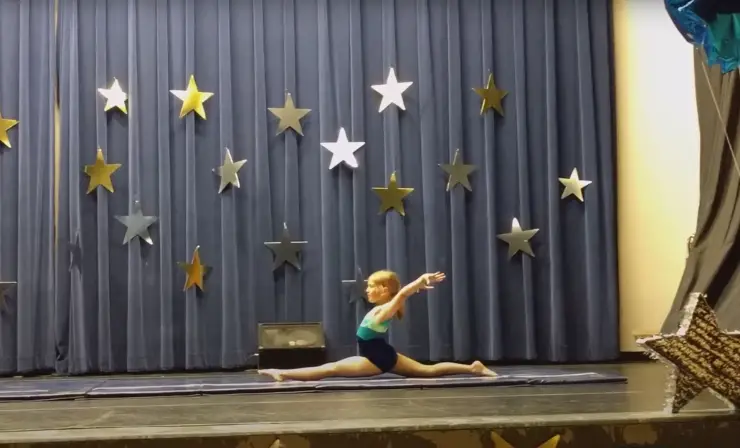
Gymnastics, with its grace and strength, is a mesmerizing addition to an elementary school talent show. This dynamic sport, including cartwheels, flips, and tumbles, creates a captivating sequence when thoughtfully choreographed. Showcasing feats like pole vault or parallel bars demonstrates dedication. Preparation is essential, with diligent practice ensuring act perfection and safety.
Pairing gymnastics with music enhances the performance, syncing movements with beats for a visually stunning and rhythmically captivating act. In conclusion, a well-executed gymnastics routine, accompanied by the right music, shines in an elementary school talent show, leaving the audience in sheer admiration.
Tips for a Gymnastics Performance
- Regular Practice: Practice diligently at home and with a gym instructor to perfect the routine and ensure safety.
- Well-Planned Routine: Create a carefully choreographed routine that highlights the gymnast’s strengths and syncs with rhythmic music.
- Music Selection: Choose upbeat, age-appropriate music to enhance the visual appeal and rhythm of the performance.
Check out this video to watch a gymnastics performance:
How to Organize a School Talent Show — 6 Steps
It takes some work to put together a quality talent show, but seeing kids bask in the cheers of their fellow students makes it all worth the effort. Here are some of the things you’ll want to think about as you prepare for your show.
Step 1: Show or Contest
First up, decide whether you want your show to just be a display of incredible talent, or if you’d like it to be a judged contest. There are benefits to both, of course, so it simply comes down to whether you want to add another layer of complexity into your planning. If it’s a contest, you’ll need judges and prizes, and you may want to break the acts into different categories.
Step 2: Date
If possible, consider holding your show during the school day. This way, all kids have the chance to participate. After-school events depend on parents’ ability and willingness to participate, and this will always leave some kids out. Remember, you can always livestream the show, or record it and make the video available for parents and friends to watch later.
Step 3: Host and Judges
Ensure you have a charismatic host to introduce acts, with candidates ranging from school principals to enthusiastic students. It’s vital for the host to pronounce names correctly and smoothly transition between acts. For a talent contest, judiciously pick your judges. Avoid parents whose children are performing to ensure fairness. Consider adding a local celebrity for extra flair. Judges should have a predefined scoring system, whether a scale or point-based categories, to make end-of-show decisions efficiently.
Step 4: Location

An auditorium or stage can be ideal for talent shows, since it likely has a sound system. Plus, acts can make use of curtains, lights, and other theater elements. But there can be benefits to holding your show in a more open space like a gymnasium too. This could allow kids to use basketball hoops for trick shots or perform bike or skateboard tricks.
Step 5: Auditions
Even if you plan to allow everyone who’s interested to participate, it’s always a good idea to hold auditions. This will give you an idea in advance of the kind of acts you can expect, and allow you to wean out any that are inappropriate for your audience. You can also see what type of equipment you’ll need on the big day and get a sense of overall timing.
Step 6: Enjoy the Show
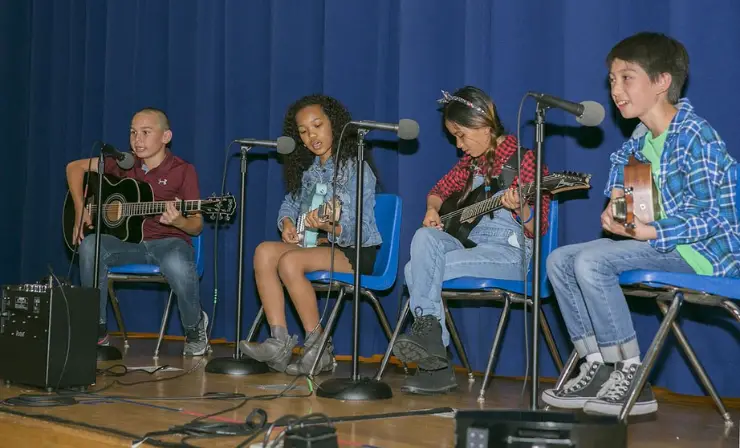
On the day of the talent show, arrive early to oversee setup and final preparations, ensuring performers have a designated backstage area and are ready for their acts. As the event begins, sit back, relax, and enjoy the talent show along with the audience, but also be prepared to address any unexpected issues that may arise during the event. Your early arrival and readiness to handle any challenges will help ensure a smooth and enjoyable experience for all.
4 More Talent Show Tips
- Consider printing programs with all the performers’ names and act information, as keepsakes for all the participants.
- If you’re holding a contest, you might want to give all participants a certificate or other small prize for participating.
- Be open to all sorts of acts, including things you’d never thought of before. Find ways to make things more inclusive. For instance, if a student wants to fold origami or braid hair, or perform some other talent that’s best seen up close, you could arrange to have their act shown up-close by projecting it onto a screen or monitor. Or kids might submit a video for something that can’t easily be performed onstage.
- Watch out for messy acts that may leave things behind on the stage that could cause problems for the next performance. Remind each act they’ll be responsible for thoroughly cleaning up after themselves, and encourage everyone to check the stage before they perform to make sure it’s safe for them.
Useful Resources
- Guidelines for School Events by National PTA
- Thirteen Costume Tips to Make Your Show a Success
- Free Printable Talent Show Certificates
Conclusion
Elementary school talent shows offer young minds a golden opportunity to express their creativity, showcase their unique skills, and build confidence. Whether it’s through dance, music, art, or even more unconventional acts, these platforms celebrate the boundless imagination and enthusiasm of youth. As educators and parents, fostering and encouraging such events can leave lasting memories and inspire a lifelong love for the arts and self-expression. Embrace the magic, and let the talents shine!
- Overview of 22 Low-Code Agencies for MVP, Web, or Mobile App Development - October 23, 2024
- Tips to Inspire Your Young Child to Pursue a Career in Nursing - July 24, 2024
- How Parents Can Advocate for Their Children’s Journey into Forensic Nursing - July 24, 2024
